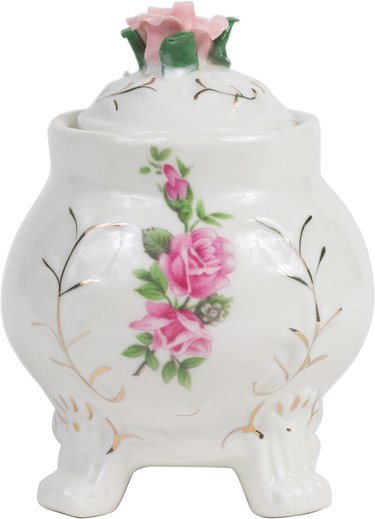
Porcelain and bone china are both materials manufactured from clay. However, it is the materials with which the clay is combined that determine the respective form it takes, porcelain or bone china. Both materials are used to make tiles, dinnerware services and decorative ornaments. Both are hard, white, vitreous elements that are considered to be highly durable.
Hard-paste Porcelain
Video of the Day
Hard-paste porcelain was the first type to be manufactured and originated in ancient China. It is comprised of kaolinite clay, feldspar and quartz. The mixture is fired at a high temperature — approximately 2,550 F — creating a dense fusion of the elements.
Video of the Day
Hard-paste Porcelain Durability
Because hard-paste porcelain is fired at a very high heat, it is a highly durable material. The high heat creates a tighter fusion of the constituent ingredients. Porcelain is thus resistant to electricity, heat and moisture, any of which could undermine its integrity if able to penetrate it.
Soft-paste Porcelain
Soft-paste porcelain derives from the initial attempts of Western travelers of the 17th century to replicate the porcelain they had seen in the East. Originally comprised of clay and ground-up glass, although now manufactured using kaolinite clay, they are generally fired at a lower heat than hard-paste porcelain.
Soft-paste Porcelain Durability
The lower firing temperature of soft-paste porcelain means that the constituent elements are not as tightly bound together, making for a less durable product.
Bone China
Bone china is a type of porcelain. It was first synthesized in approximately 1800 by Josiah Spode in the U.K. It takes its name from the proportion — a minimum of 25 percent but typically 50 percent — of bone ash, derived from animal bones. The bones are thoroughly stripped of meat and sinew before being burned at very high temperatures. The resulting ash is mixed with china clay and feldspar — previously china stone — and fired to create bone china.
Bone China Durability
Bone china is the most durable type of porcelain. It can be fired at a temperature as low as 1,450 F to produce the same strength as hard-paste porcelain fired at the higher temperature. The inclusion of the bone ash means that bone china is less brittle than other types of porcelain and, thus, less prone to chipping or cracking.